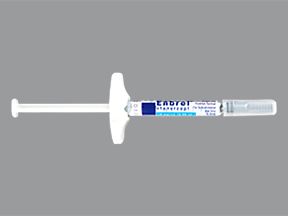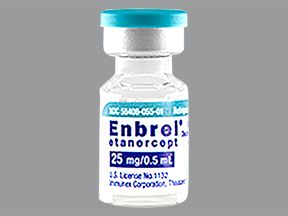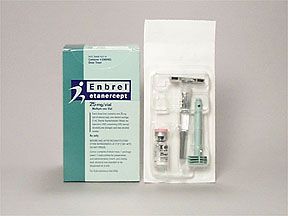Enbrel (etanercept) is a prescription brand-name medication. The Food and Drug Administration (FDA) has approved it to treat these conditions:
- plaque psoriasis in adults as well as children ages 4 years and older
- psoriatic arthritis in adults
- rheumatoid arthritis in adults
- polyarticular juvenile idiopathic arthritis in children ages 2 years and older
- ankylosing spondylitis in adults
The active drug in Enbrel is etanercept, which is classified as a tumor necrosis factor (TNF) blocker.
Enbrel is given as a subcutaneous injection and is available in several forms.
For information about common dosages of Enbrel, including its forms, strengths, and how to use the drug, keep reading. For a comprehensive look at Enbrel, see this article.
This article describes typical dosages for Enbrel provided by the drug’s manufacturer. When using Enbrel, always follow the dosage prescribed by your doctor.
Keep reading for information about Enbrel dosages commonly used for conditions it’s approved to treat, as well as details about Enbrel’s forms and strengths.
Enbrel forms and strengths
Enbrel is available in the following forms and strengths. The strengths are listed as milligrams (mg) per milliliter (mL):
- liquid solution in single-dose prefilled syringes: 25 mg/0.5 mL and 50 mg/mL
- liquid solution in single-dose prefilled SureClick autoinjectors: 50 mg/mL
- liquid solution in Enbrel Mini single-dose prefilled cartridges:* 50 mg/mL
- liquid solution in single-dose vials:† 25 mg/0.5 mL
- powder that’s mixed into a liquid solution in a multiple-dose vial:† 25 mg/mL once mixed
* The cartridges are used in AutoTouch reusable autoinjectors.
† This form requires a syringe and needle to draw up the dose.
Typical dosages
The following information describes typical Enbrel dosages that are commonly used or recommended. However, be sure to use the dosage your doctor prescribes for you. Your doctor will determine the best dosage to fit your needs.
Enbrel is given as a subcutaneous injection. You should try to use the drug on the same day or days each week.
Dosage for plaque psoriasis
For treating plaque psoriasis in adults, the typical Enbrel starting dosage is a 50-mg injection twice per week for 3 months. A starting dose contains a higher dose of the drug so it can start working quickly.
After 3 months, your doctor will probably switch you to a maintenance dose of 50 mg once per week. A maintenance dose helps “maintain” your treatment long term.
Dosage for psoriatic arthritis
The Enbrel dosage for psoriatic arthritis is 50 mg once per week. Enbrel may be used alone or with the drug methotrexate (Trexall).
Dosage for rheumatoid arthritis
The Enbrel dosage for rheumatoid arthritis is 50 mg once per week. Enbrel may be used alone or with the drug methotrexate (Trexall).
Dosage for polyarticular juvenile idiopathic arthritis
The Enbrel dosage for polyarticular juvenile idiopathic arthritis is based on your child’s body weight.
- Children who weigh 138 pounds (lb) or more: They’ll receive a 50-mg injection of Enbrel once per week. A weight of 138 lb is about 63 kilograms (kg).
- Children who weigh less than 138 lb (about 63 kg): The Enbrel dosage is 0.8 milligrams (mg) per kg of body weight once per week. Your child’s doctor or pharmacist will calculate the correct dose.
For doses that are based on weight, your child will likely need the Enbrel single- or multidose vials. Your doctor or pharmacist can show you how to prepare your child’s dose using these vials. (For more information, see the “How to use” section below.)
Note: Whatever your child’s weight is, their Enbrel dose should not be more than 50 mg per week.
Dosage for ankylosing spondylitis
The Enbrel dosage for ankylosing spondylitis is 50 mg once per week.
Long-term use
Enbrel is meant to be used as a long-term treatment. If you and your doctor determine that Enbrel is safe and effective for you, you’ll likely use it long term.
Children’s dosage
Enbrel is approved to treat the following conditions in children:
- plaque psoriasis in children ages 4 years and older
- polyarticular juvenile idiopathic arthritis in children ages 2 years and older
Dosage for polyarticular juvenile idiopathic arthritis
You can find the Enbrel dosage for polyarticular juvenile idiopathic arthritis in children ages 2 years and older above. See “Dosage for polyarticular juvenile idiopathic arthritis.”
Dosage for plaque psoriasis in children
The Enbrel pediatric dosage for plaque psoriasis in children ages 4 years and older is the same as the dosage for polyarticular juvenile idiopathic arthritis. See “Dosage for polyarticular juvenile idiopathic arthritis” above.
Below are answers to some frequently asked questions about Enbrel dosages.
What is Enbrel’s dosage for psoriasis?
Enbrel is used to treat two forms of psoriasis:
- plaque psoriasis in adults as well as children ages 4 years and older
- psoriatic arthritis in adults
For information about the Enbrel dosages for these conditions, see the “Enbrel dosage” section above.
What’s the dosage for Enbrel Mini?
Enbrel Mini is a form of Enbrel, so for dosage information, see the “Enbrel dosage” section above.
Enbrel Mini comes as a single-dose prefilled cartridge with a reusable AutoTouch autoinjector. The cartridge is available in one strength: 50 milligrams per milliliter (mg/mL).
For more information about Enbrel Mini, including how to use it to give a dose, you can view this video on the manufacturer’s website.
If you have additional questions about Enbrel Mini and Enbrel dosages, speak with your doctor or pharmacist.
Does Enbrel come as tablets and a pen? If so, what are the dosages for each form?
No, Enbrel doesn’t come as tablets or as a pen. But it does come in an autoinjector, which is similar to some pens used to inject other medications.
For information about the different forms of Enbrel, see “Enbrel forms and strengths” above. You can also talk with your doctor or pharmacist if you have additional questions.
Can Enbrel be used twice weekly?
If you’re an adult using Enbrel to treat plaque psoriasis, your doctor may have you use the drug twice weekly for a time.
You’ll likely begin Enbrel treatment by receiving a starting dose of 50 mg twice per week for 3 months. Then your doctor will typically switch you to a maintenance dose of 50 mg once per week.
A starting dose contains a higher dose of the drug so it can start working quickly. A maintenance dose helps “maintain” your treatment long term.
For more information about Enbrel dosages, see “Enbrel dosages” above. You can also talk with your doctor or pharmacist.
The Enbrel dosage your doctor prescribes will depend on several factors. These include:
- the type and severity of the condition you’re using Enbrel to treat
- the form of Enbrel you use
- your age
How to use Enbrel depends on the form your doctor prescribes. Be sure to follow your doctor’s instructions about Enbrel dosage and administration.
Enbrel is given as a subcutaneous injection. Whichever form of Enbrel you use, a healthcare professional will typically first show you how to give a dose. Then you can give yourself injections at home.
Enbrel injections can be given under the skin in three areas. These are the thigh, back of your upper arm, and belly (at least 2 inches away from your belly button).
The manufacturer of Enbrel offers instructional videos about how to use each form of Enbrel. You may view these videos here. You can also refer to the drug’s instructions for the form of Enbrel you’re using:
- single-dose prefilled SureClick autoinjector
- single-dose prefilled syringe
- single-dose vial
- multiple-dose vial
- AutoTouch reusable autoinjector with Enbrel Mini cartridges
Here are some tips to keep in mind with Enbrel:
- You should take Enbrel out of the refrigerator at least 30 minutes before a dose. This lets the drug come to room temperature, which may make the injection more comfortable.
- Enbrel that comes in a vial must be mixed and drawn into a syringe to give a dose. Once mixed, the solution is good for 14 days.
- If you use the SureClick autoinjector, it’s important that you take your dose within 5 minutes of removing the syringe cap. Otherwise, the syringe may dry out with the cap off.
- If you use the AutoTouch reusable autoinjector with Enbrel Mini cartridges, you’ll replace the cartridge for each new injection. The injector is reusable.
- The AutoTouch injector comes with light and sound indicators that tell you when your dose has been completely injected.
- It’s important to dispose of used syringes, Enbrel Mini cartridges, and single-use autoinjectors in a sharps container. You should not reuse syringes or throw them in the trash. For more information about disposing of sharps, see these
FDA guidelines .
If you miss a dose of Enbrel, take it as soon as you remember. But you should not have two Enbrel injections at once to make up for a missed dose.
If you’re unsure about what to do regarding a missed dose, talk with your doctor or pharmacist. They can also help you get your Enbrel dosing schedule back on track.
To help make sure that you don’t miss a dose, try using a medication reminder. This can include setting an alarm or timer on your phone or downloading a reminder app. A kitchen timer can work, too.
It’s important that you do not use more Enbrel than your doctor prescribes. For some medications, using more than the recommended amount may lead to side effects or overdose.
If you use more than the recommended amount of Enbrel
Call your doctor right away if you believe you’ve used too much Enbrel. Another option is to call the American Association of Poison Control Centers at 800-222-1222 or use its online tool. If you have severe symptoms, immediately call 911 or your local emergency number, or go to the nearest emergency room.
The dosages in this article are typical dosages provided by the drug manufacturer. If your doctor recommends Enbrel for you, they will prescribe the dosage that’s right for you. Always follow the dosage that your doctor prescribes for you.
As with any drug, never change your dosage of Enbrel without your doctor’s recommendation. If you have questions about the dosage of Enbrel that’s right for you, talk with your doctor.
Besides learning about dosage, you may want other information about Enbrel. These additional articles might be helpful to you:
- More about Enbrel. For information about other aspects of Enbrel, refer to this article.
- Side effects. To learn about side effects of Enbrel, see this article. You can also look at the Enbrel medication guide.
- Drug comparison. To find out how Enbrel compares with Humira, read this article. And to learn how Enbrel compares with Remicade, see this article.
- Information about Medicare coverage. See this article for information about whether Medicare covers Enbrel treatment.
- Details about your condition. For details about your condition, see our:
- list of rheumatology articles
- list of psoriasis articles, as well as this article about Enbrel for psoriatic arthritis
- list of psoriatic arthritis articles
Disclaimer: Medical News Today has made every effort to make certain that all information is factually correct, comprehensive, and up to date. However, this article should not be used as a substitute for the knowledge and expertise of a licensed healthcare professional. You should always consult your doctor or another healthcare professional before taking any medication. The drug information contained herein is subject to change and is not intended to cover all possible uses, directions, precautions, warnings, drug interactions, allergic reactions, or adverse effects. The absence of warnings or other information for a given drug does not indicate that the drug or drug combination is safe, effective, or appropriate for all patients or all specific uses.



